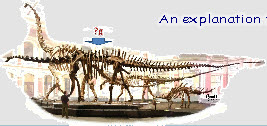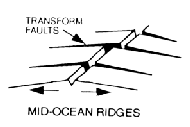


more evidence for Earth expansion
The science journal Nature just reported, on the 17th March 2021, that transform faults stretch and grow.
This is astonishing for Plate Tectonic theory because, as the News and Views section of Nature explained, “Tectonic-plate material is generally thought to be neither created nor destroyed at plate boundaries called oceanic transform faults. An analysis of sea-floor topography suggests that this assumption is incorrect”.
While this discovery is a problem for Plate Tectonics, requiring the development of some complex ad hoc theories to account for the stretching, it isn’t a problem for the rival theory of Earth expansion. In fact it has long been predicted that transform faults will be widening if the Earth is expanding.
Transform faults have been known about for many years. If we look at some of the first maps of the ocean floor, produced from 1959 onwards by Bruce Heezen and Marie Tharp, we can very clearly see transform faults on the ocean floor positioned at right angles to the ocean ridges. The main feature of the ocean floor is the ocean ridge stretching around the world. The short video below follows the ocean ridge around the globe but at right angles to it we can clearly see the transform faults. They are tectonically active areas that can cross entire ocean basins.
Plate Tectonics describes these transform faults as areas where two segments of crust slide past each other to produce shearing. So the two segments shouldn’t be moving apart on a constant diameter Earth. As the authors of the paper, Extensional tectonics and two-stage crustal accretion at oceanic transform faults by Grevemeyer et al (2021), explain in the abstract,
“Oceanic transform faults are seismically and tectonically active plate boundaries that leave scars—known as fracture zones—on oceanic plates that can cross entire ocean basins. Current descriptions of plate tectonics assume transform faults to be conservative two-dimensional strike–slip boundaries at which lithosphere is neither created nor destroyed and along which the lithosphere cools and deepens as a function of the age of the plate. However, a recent compilation of high-resolution multibeam bathymetric data from 41 oceanic transform faults and their associated fracture zones that covers all possible spreading rates shows that this assumption is incorrect. Here we show that the seafloor along transform faults is systemically deeper (by up to 1.6 kilometres) than their associated fracture zones, in contrast to expectations based on plate-cooling arguments. Accretion at intersections between oceanic ridges and transform faults seems to be strongly asymmetric: the outside corners of the intersections show shallower relief and more extensive magmatism, whereas the inside corners have deep nodal basins and seem to be magmatically starved.”
In the main paper the authors explain how,
“In the original framework for plate tectonics, transform faults were proposed to be conservative, two-dimensional features at which lithosphere of different ages touch, leading to flexural adjustment and differential subsidence with age across fracture zones. Once formed at a ridge–transform intersection, magmatic crust at the inside corner … was proposed to be carried along the transform without further modification, becoming part of the fracture zone after passing the opposite ridge–transform intersection”
But they didn’t find that. They found that the area within the transform fault is subject to extension that causes the valley to be deeper than the adjacent seafloor. The thinning and stretching within the transform area occurs at rates of about 4-20 mm per year.
Since this is not what Plate Tectonic predicts, most of the paper is concerned with a proposed ad hoc theory to explain how this could possibly be happening. There is no mention that this crustal stretching is exactly what Earth expansion predicts. This isn’t surprising since the authors would have found it almost impossible to get their paper published in Nature if they had mentioned Earth expansion. In practice the editors of Nature hurriedly reject any papers providing evidence of Earth expansion [see Koziar (2018, p2) for a description of this practice occurring on 9 May 2018].
However, expansionists have predicted for decades that these transform faults would be stretching. Here’s how I described my understanding of transform faults using an Earth expansion framework in the various editions of my book, Dinosaurs and the Expanding Earth.
“On examining the newly formed ocean floor at the ocean ridges it is possible to observe transform faults running at right angles to the ocean ridges [as shown in the figure]. These faults are kilometres wide in places. An indication of how these transform faults would occur on an expanding earth can be gained by imagining a section of any small sphere being placed on a larger sphere. The smaller section will not fit unless the outer edges of the small section are torn apart. This same effect would tend to tear the outer edges of the ocean floor to produce the transform faults.”
I’ve obviously been happy with that description of transform faults since it’s in the 1996 edition (p126), the 2003 edition (p69) and the most recent 2011 edition (p116, 117). The description is based on the work of many authors and is well known amongst expansionists. Now I reread it, it occurs to me that I don’t actually explain that new younger ocean floor would fill the gap as the transform faults are torn apart. But it seems obvious that as the crust thins and stretches new magma must fill the gap created. Just as these new studies of Grevemeyer et al (2021) show.
Comment on Facebook
References
Grevemeyer, I., Rüpke, L.H., Morgan, J.P., Iyer, K., Devey, C. (2021). Extensional
tectonics and two-stage crustal accretion at oceanic transform faults. Nature 591,
402–407 (2021).
Abstract & Paywall pdf
Hurrell, S.W. (2011). Dinosaurs and the Expanding Earth. 3rd edition. ISBN: 9780952260370.
Oneoff Publishing.com.
Book details Google Scholar
Koziar, J. (2018). Expansion of the World Geodetic Ellipsoid.
Free pdf Google
Scholar
Page created 26 Mar 2021
Page updated 26 Mar 2021

And here’s the simple sketch of the transform faults contained in the book. It also has a short description to emphasise the point, “In the ocean floor giant tears or transform faults are found running at right angles to ocean ridges indicating that the earth is being torn apart in these places”
Share this page




